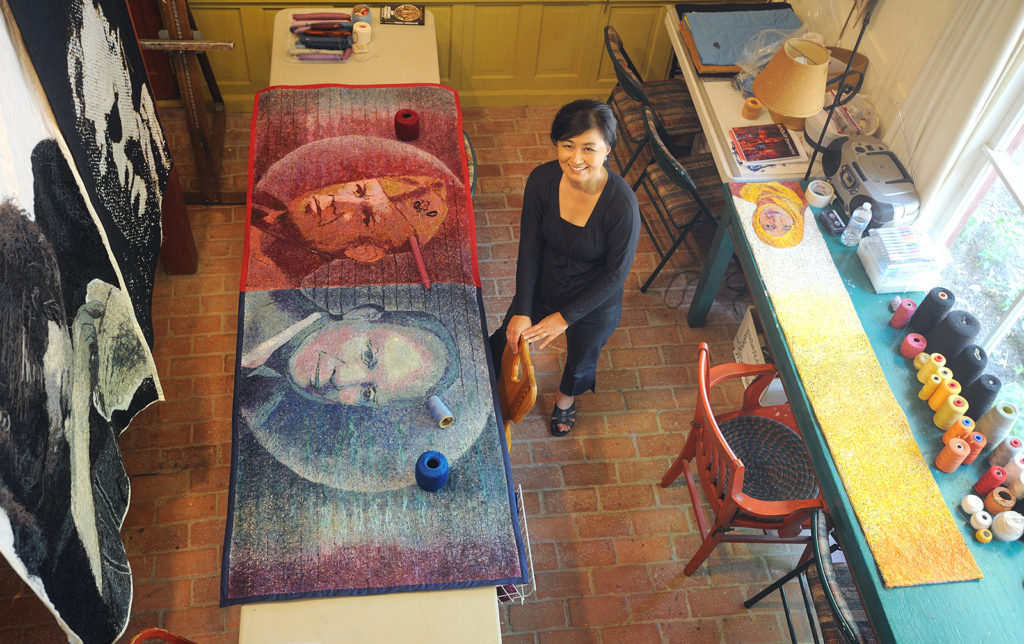
Bio
Shin-hee Chin is a fiber/mixed-media artist and Professor in the Visual Art Department at Tabor College. Chin’s work has been exhibited nationally and internationally, including Washington DC, Tokyo, Hampton, Geneva, Tainan, and Seoul.
Chin’s work was featured as the cover of the Studio Art Quilt Associates Journal (Spring 2017) and the cover of Surface Design Association Journal (Summer 2014).
As an esteemed educator for 17 years, Chin has taught drawing, painting, color theory, and mixed media. She was elected as Distinguished Faculty in 2008. Influenced by feminist traditions, Christian spirituality, and Eastern philosophy, Chin has created a coherent narrative addressing the complex issues of the female body, procreation and motherhood, mother tongue, cultural identity, cultural hybridity, and sense of belonging.
Contact
- Email: shinheec@tabor.edu
- Instagram: @shinheechin
- Facebook: @shinhee.chin
- Full CV available here
Statement
Cultural context has most shaped my work as I have spent half my life in South Korea and the past two decades in the United States. I have had equal exposure to two vastly different cultures. In my years dealing with issues of a bi-cultural lifestyle, art has helped me reconcile the conflicting nature of these influences. My work reflects this binary approach – female vs. male, East vs. West, art vs. craft – all those paradoxes inhabit the same space just as both Korea and America co-exist in me. From these cultures, I draw inspiration specifically from the feminist tradition, Christian spirituality, and Eastern philosophy.
In my work, I attempt to carve out what I proudly call a feminine territory in which the voices of effaced and silenced women reverberate, and to translate the experiences of women in a way that people of different ethnic backgrounds and cultural experiences can understand. For that purpose, I utilize needle, thread, and fabric to call into question the deep-seated bias that women’s work is menial, marginal and undesirable. I convert the conventional “feminine” activity of needlework into a useful medium for the making of art. Each collage from fabric that was cut, ironed, pasted, and stitched. In addition to fabric and needlework, I use sumi ink, acrylic/oil paints, various papers, and calligraphic techniques.
The slow nature of my technique mimics the creative process of birthing. This recalls the gradual forming of the fetus through the intersection of capillary within the belly of the mother or the silkworm’s patient and continuous spinning leading to the creation of its cocoon. The techniques have an important meaning for me both as a compositional device and as an obsessive activity. In experimenting with a variety of “domestic” media such as clothes, threads, and paper, my hands participate in the process of the intricate linking of the irregular pattern of threads that form vein, skin, and scar. Thus, these pieces speak not so much of sorrow, anger, regrets, but rather, of healing, recovering, inner joy attained by/through converting the physical, oppressive condition into the stimulating and dynamic inner resources for creative life. Through the strategic use of media that have been traditionally associated with the feminine, I want to show that seemingly ‘trivial female work’ can be a source of pleasure and power for women.
While feminism has influenced my choice in media and technique, my Christianity has shaped concepts and themes in my work. Art and spirituality serve similar functions in my life. Art uses visual elements to explore and communicate truth; spirituality is just another mode of my exploration and communication of truth. They both help me understand life and this world.
Eastern philosophy, on the other hand, has shaped my art-making in terms of process and approach. My role in relationship to my work is more as a “collaborator” than as a creator. This conception echoes the Eastern understanding of art and artists. Eastern philosophy, in contrast to Western philosophy, conceived the self-effacement and non-mindedness of an artist as the primary step to be taken before Nature could truly be free at work. By working with the nature of the material, the work maintains integrity. Art then becomes the product of a dialogue with Nature, rather than the process of subduing it.
